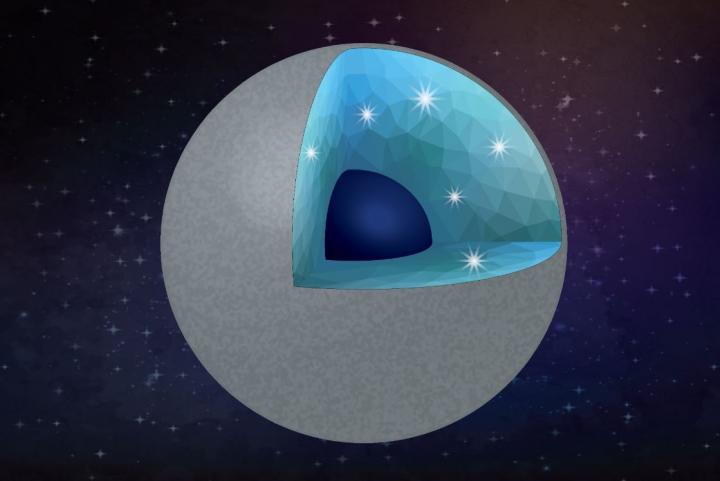Carbon-rich exoplanets may be made of diamonds

Illustration of a carbon-rich planet with diamond and silica as main minerals. Water can convert a carbide planet into a diamond-rich planet. In the interior, the main minerals would be diamond and silica (a layer with crystals in the illustration). The core (dark blue) might be iron-carbon alloy.
Credit: Shim/ASU/Vecteezy
As missions like NASA’s Hubble Space Telescope, TESS and Kepler continue to provide insights into the properties of exoplanets (planets around other stars), scientists are increasingly able to piece together what these planets look like, what they are made of, and if they could be habitable or even inhabited.
In a new study published recently in The Planetary Science Journal, a team of researchers from Arizona State University (ASU) and the University of Chicago have determined that some carbon-rich exoplanets, given the right circumstances, could be made of diamonds and silica.
“These exoplanets are unlike anything in our solar system,” says lead author Harrison Allen-Sutter of ASU’s School of Earth and Space Exploration.
Diamond exoplanet formation
When stars and planets are formed, they do so from the same cloud of gas, so their bulk compositions are similar. A star with a lower carbon to oxygen ratio will have planets like Earth, comprised of silicates and oxides with a very small diamond content (Earth’s diamond content is about 0.001%).
But exoplanets around stars with a higher carbon to oxygen ratio than our sun are more likely to be carbon-rich. Allen-Sutter and co-authors Emily Garhart, Kurt Leinenweber and Dan Shim of ASU, with Vitali Prakapenka and Eran Greenberg of the University of Chicago, hypothesized that these carbon-rich exoplanets could convert to diamond and silicate, if water (which is abundant in the universe) were present, creating a diamond-rich composition.
Diamond-anvils and X-rays
To test this hypothesis, the research team needed to mimic the interior of carbide exoplanets using high heat and high pressure. To do so, they used high pressure diamond-anvil cells at co-author Shim’s Lab for Earth and Planetary Materials.
First, they immersed silicon carbide in water and compressed the sample between diamonds to a very high pressure. Then, to monitor the reaction between silicon carbide and water, they conducted laser heating at the Argonne National Laboratory in Illinois, taking X-ray measurements while the laser heated the sample at high pressures.
As they predicted, with high heat and pressure, the silicon carbide reacted with water and turned into diamonds and silica.
Habitability and inhabitability
So far, we have not found life on other planets, but the search continues. Planetary scientists and astrobiologists are using sophisticated instruments in space and on Earth to find planets with the right properties and the right location around their stars where life could exist.
For carbon-rich planets that are the focus of this study, however, they likely do not have the properties needed for life.
While Earth is geologically active (an indicator habitability), the results of this study show that carbon-rich planets are too hard to be geologically active and this lack of geologic activity may make atmospheric composition uninhabitable. Atmospheres are critical for life as it provides us with air to breathe, protection from the harsh environment of space, and even pressure to allow for liquid water.
“Regardless of habitability, this is one additional step in helping us understand and characterize our ever- increasing and improving observations of exoplanets,” says Allen-Sutter. “The more we learn, the better we’ll be able to interpret new data from upcoming future missions like the James Webb Space Telescope and the Nancy Grace Roman Space Telescope to understand the worlds beyond on our own solar system.”
Media Contact
All latest news from the category: Physics and Astronomy
This area deals with the fundamental laws and building blocks of nature and how they interact, the properties and the behavior of matter, and research into space and time and their structures.
innovations-report provides in-depth reports and articles on subjects such as astrophysics, laser technologies, nuclear, quantum, particle and solid-state physics, nanotechnologies, planetary research and findings (Mars, Venus) and developments related to the Hubble Telescope.
Newest articles

High-energy-density aqueous battery based on halogen multi-electron transfer
Traditional non-aqueous lithium-ion batteries have a high energy density, but their safety is compromised due to the flammable organic electrolytes they utilize. Aqueous batteries use water as the solvent for…

First-ever combined heart pump and pig kidney transplant
…gives new hope to patient with terminal illness. Surgeons at NYU Langone Health performed the first-ever combined mechanical heart pump and gene-edited pig kidney transplant surgery in a 54-year-old woman…

Biophysics: Testing how well biomarkers work
LMU researchers have developed a method to determine how reliably target proteins can be labeled using super-resolution fluorescence microscopy. Modern microscopy techniques make it possible to examine the inner workings…





















